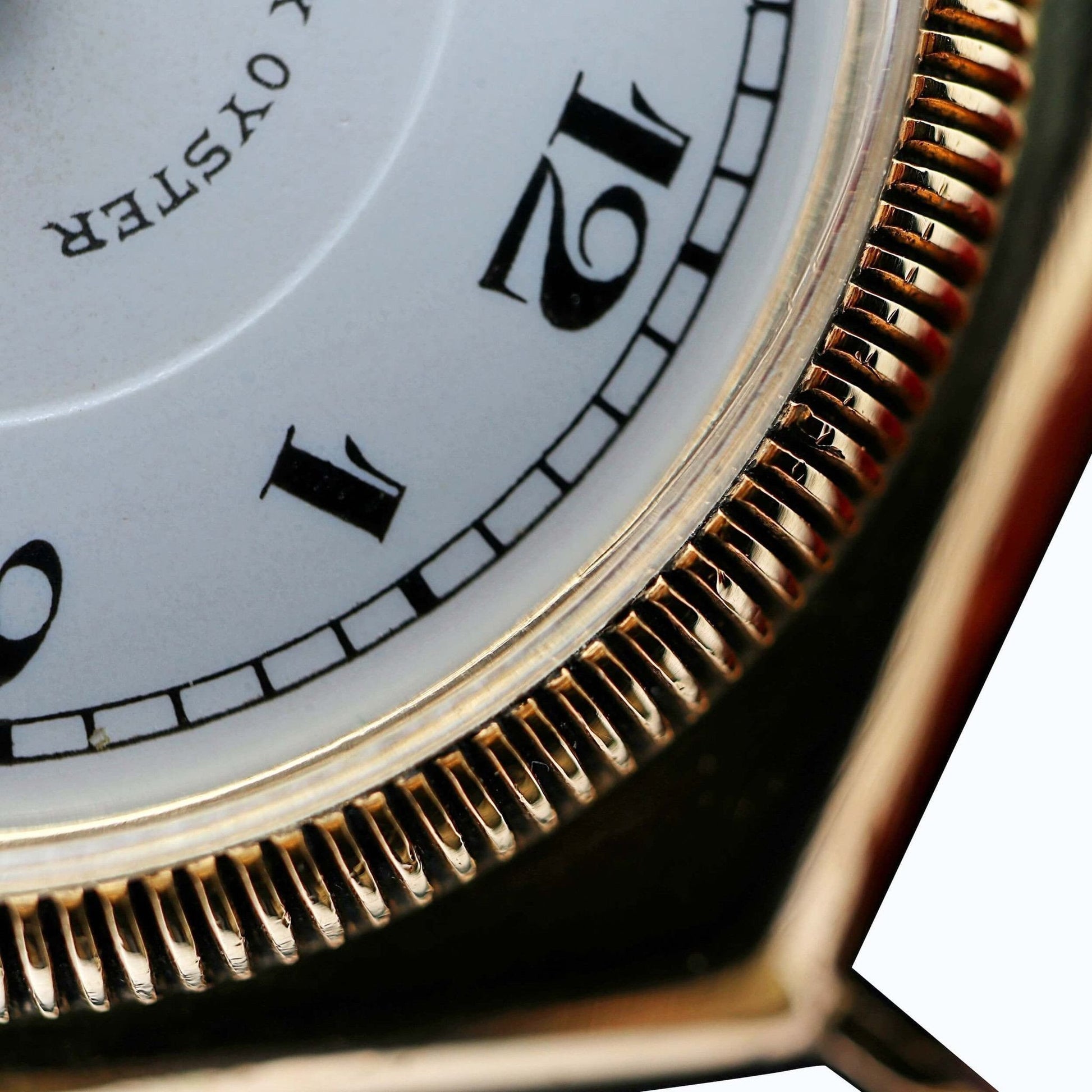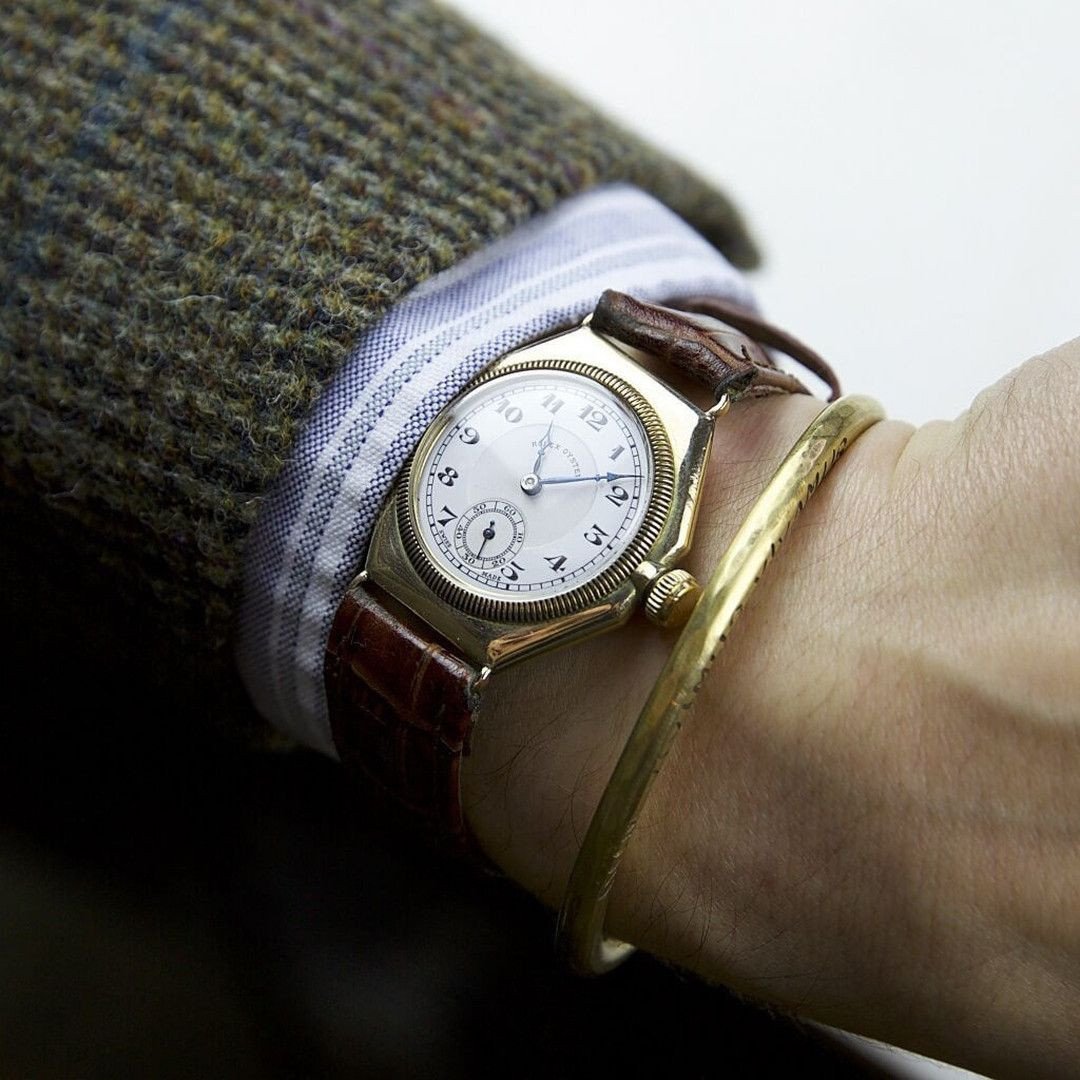Rolex
Rolex Oyster Men's Vintage 1929 Gold Watch
Rolex Oyster Men's Vintage 1929 Gold Watch
Authenticity Guaranteed
Traditional Dealer Price
Regular priceHelp Me Find A Similar Watch!
Enter your details below and we will be in touch to find a similar watch.
Couldn't load pickup availability
Have a question?
Call us on 0203 8156 488 or WhatsApp us or Send us a Message
Have similar watch to sell?
We offer up-to 30% more than the competition. Get a quote.
Rolex Oyster 9ct Gold - A beautiful example of one of the most important horological timepieces of the 20th Century, dating from 1929, this stunning 9ct Rolex Oyster has been well looked after and is in fantastic working condition, having just undergone a full professional service.
The Rolex Prima movement has 15 rubies, timed to 6 positions and for all climates. The watch has a beautiful engine turned silver dial, black Arabic numerals and centre seconds. The dial is signed Rolex Oyster above the centre and is offset beautifully by blue steel hands.
The case is signed RWC Ltd (Rolex Watch Company), Rolex, 20 World Records, Great Britain patents, 260554/1925, 274.789, Swiss patents, 114.948, 120851, case serial No 27321/679. The respective hallmarks for Glasgow and 1929 are also present. The screw back cover has a personal engraving reading "W J P Gayton Feb 26th, 1951 from Mum & Dad" adding a further layer to the unique story of this piece.
An original period Rolex box is also included.
This watch is a great investment piece and sure to see strong growth in coming years. As with all our investment grade watches, it’s also backed by our Buy Back Guarantee for added peace of mind.
Background:
Released in 1926 to the backdrop of the “Roaring Twenties”, the original Rolex Oyster was one of the most important timepieces in modern horology.
It’s the story of a world first, controversy and marketing genius.
To set the scene we must first understand the background of the brand and its founder; Hans Wilsdorf. As a self-professed merchant, Wilsdorf was not a watchmaker by profession (nor for that matter was he Swiss), but rather an incredibly astute salesman and marketer.
During the time Wilsdorf ran the company Rolex never made watches from scratch as it does today, but instead assembled its watches from components manufactured by third party suppliers. Wilsdorf’s skill was that of an entrepreneur; identifying market problems and opportunities, be it stylistic or functional and then creating the solutions to meet them.
Arguably the most notable example of this was the Rolex Oyster, its creation stemming from solving two problems with watches of the day. The first was one of perception. Consumers (and in many cases justifiably) perceived wrist watches with their smaller movements to be less accurate than their pocket watch counterparts. The second was an issue of durability with watches of the time suffering from intrusion of water, dust and other foreign particles into their movements.
To resolve the first problem, Wilsdorf submitted his watches to both Swiss and Kew laboratories to prove their accuracy – a practice that still continues today. For the Oyster, the movements came in three versions, all 15 jewels constructions, they were separated on the basis of their tested accuracy. The three versions were; Prima, Extra Prima and Ultra Prima, with the Ultra Prima representing the most accurate version and accounting for only the top 10% of Oyster watches.
The second issue presented more of a challenge. Prior to the invention of the Oyster, watches were protected from the elements by means of a Hermetic casing. In essence, this called for the watch to be completely encased in a second outer case that would provide protection from the elements. However, this design had two major drawbacks, the first was durability. With cases often made from gold or silver, both soft metals, the daily unscrewing of the bezel would lead to wear, compromising its protective qualities and making it difficult to unscrew. The second was one of inconvenience, for every time you wanted to wind the movement or change the time you would have to remove it from its protective case.
Wilsdorf sought a solution to these issues and in 1926 found it by way of Swiss patent no. 114948 filed by Paul Perregaux and Georges Perret on 30th October, 1925 for a winding system where the crown could be screwed down onto the case creating a waterproof seal. Instead of simply purchasing the patent as some report, the truth was more complex, and in our opinion far more interesting.
In 2010, watch historian David Boettcher provided new insight into the story via his article in the US National Association of Watch & Clock Collectors (NAWCC) Bulletin. In it, Boettcher showed the patent wasn't purchased directly by Wilsdorf as some believed but instead was first acquired by Charles Rodolphe Spillmann on July 19, 1926. Just days later the patent would be transferred again, this time to Wilsdorf.
Whether Wilsdorf used Spillmann as a middleman or Spillmann himself found the patent and brought it to Wilsdorf is not known. However, what is known is that Spillmann just so happened to own a case making firm in La Chaux-de-Fonds which would go on to produce almost all of the gold cases used by the Rolex Oyster, a reward for alerting Wilsdorf of this design or just mere coincidence? Regardless, with the patent transferred, shortly after on the 29th July 1926, with his design complete Wilsdorf registered the “Oyster” trademark.
A story on the Rolex Oyster wouldn’t be complete without the mention of Mercedes Gleitze. Having developed and tested the Oyster in 1926, Hans Wilsdorf needed a way to market his latest creation. Ever the marketer, he sensed his chance in 1927 upon hearing of Mercedes Gleitze attempt to re-swim the English Channel.
Now if you were to believe the account as retold by several books on the brand, you may believe that Mercedes successfully swam the width of the English Channel on October 21st, 1927 whilst wearing a Rolex Oyster on her wrist and upon arriving on the shores of France the watch was proclaimed as being in perfect working order. However, as is the case with several famous stories about the brand the truth is slightly more complex.
On October 7th, 1927, Mercedes Gleitze, a stenographer and keen swimmer would become the first English woman to swim the English Channel. This achievement had not been an easy one; in fact, it was her eighth attempt, her first being in 1922. If it were not for a twist of fate her accomplishment may well have been lost to history. However, in the days following conspiracy stories started to circulate about the validity of her attempt, culminating in the Channel Swimming Association refusing to acknowledge her achievement.
Whilst others may have succumbed to the pressure, so angered with being branded a liar, Mercedes announced she'd swim it again in the coming days to prove her achievement beyond doubt. Naturally, this led to a significant amount of press coverage from which Hans Wilsdorf got wind of Mercedes’ story. Seeing the perfect opportunity to garner worldwide exposure for his waterproof watch, Hans spared no time and on October 14th, 1927 wrote to Glietze formally offering to provide her with a watch to be worn on the upcoming swim. In exchange, Gleitze was to provide a written testimonial on the performance of the watch after the swim.
On October 21st, 1927, Gleitze set off on what was known as her “vindication swim.” It would be here where I would like to say, as many do, that with her Rolex Oyster strapped securely to her wrist she successfully completed the crossing for the second time, however, this was not to be the case. Unfortunately, the water was considerably colder than on her previous attempt and some seven miles from her goal, succumbing to the effects of the cold water, Gleitze had to give up on her attempt.
Although visibly disappointed, the resounding opinion of onlookers and medics was that whilst not reaching her goal that day, her endurance given the conditions was good enough to remove any doubt that she had in fact previously completed the journey.
It was whilst recovering on the support boat that a reporter from The London Times noted, "Hanging round her neck by a riband on this swim, Miss Gleitze carried a small gold watch, which was found this evening to have kept good time throughout." The watch, of course, was the Rolex Oyster given to her by Wilsdorf, a convenient quote perhaps, but nonetheless, the proof needed by Wilsdorf to show off the abilities of his waterproof watch. On October 25th, 1927 Gleitze fulfilled her end of the deal, forwarding a letter to Rolex with a favourable review of the watch's performance in challenging conditions.
On November 24, 1927, Wilsdorf purchased a full page ad on the British newspaper, The Daily Mail reading: "Rolex introduces for the first time the greatest triumph in Watch-making – ROLEX ‘OYSTER' – The Wonder Watch That Defies The Elements. MOISTURE-PROOF WATER PROOF HEAT PROOF VIBRATION PROOF COLD PROOF DUST PROOF"
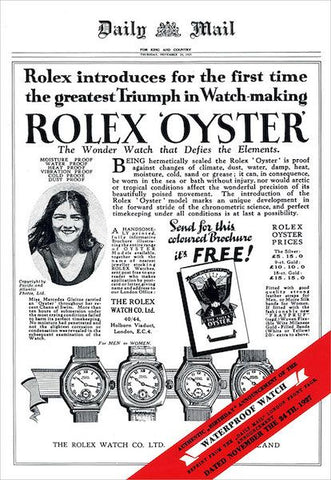
The Rolex – Gleitze connection is fascinating on many levels. It marked the introduction of a truly revolutionary watch, the first use of female celebrity endorsement by Rolex and the effect of hearsay on moulding cornerstone brand stories.
As for Gleitze, she would complete 51 endurance swims, over half of them lasting over 26 hours. She would also go on to establish a fund for Destitute Men and Women and inspire women and girls to realise their true potential.
A truly amazing watch and an even more amazing woman.
Condition Report:
Like all our watches this has been professionally serviced and regulated by our watch maker as well as authenticated by a independent third party.
- Dial: In excellent condition having previously been restored;
- Hands: Hands show noticeable marks and tarnishing when viewed under a 4x loupe;
- Glass: Visible minor scratches;
- Case: Visible marks, scratches and dints to the naked eye. Crown shows scratches;
- Movement: Fully serviced & regulated. Movement shows marks and tarnishing commensurate with general wear visible when viewed under a 4x loupe;
- Strap: Replacement leather strap showing signs of wear and creasing. Scratches to the buckle.
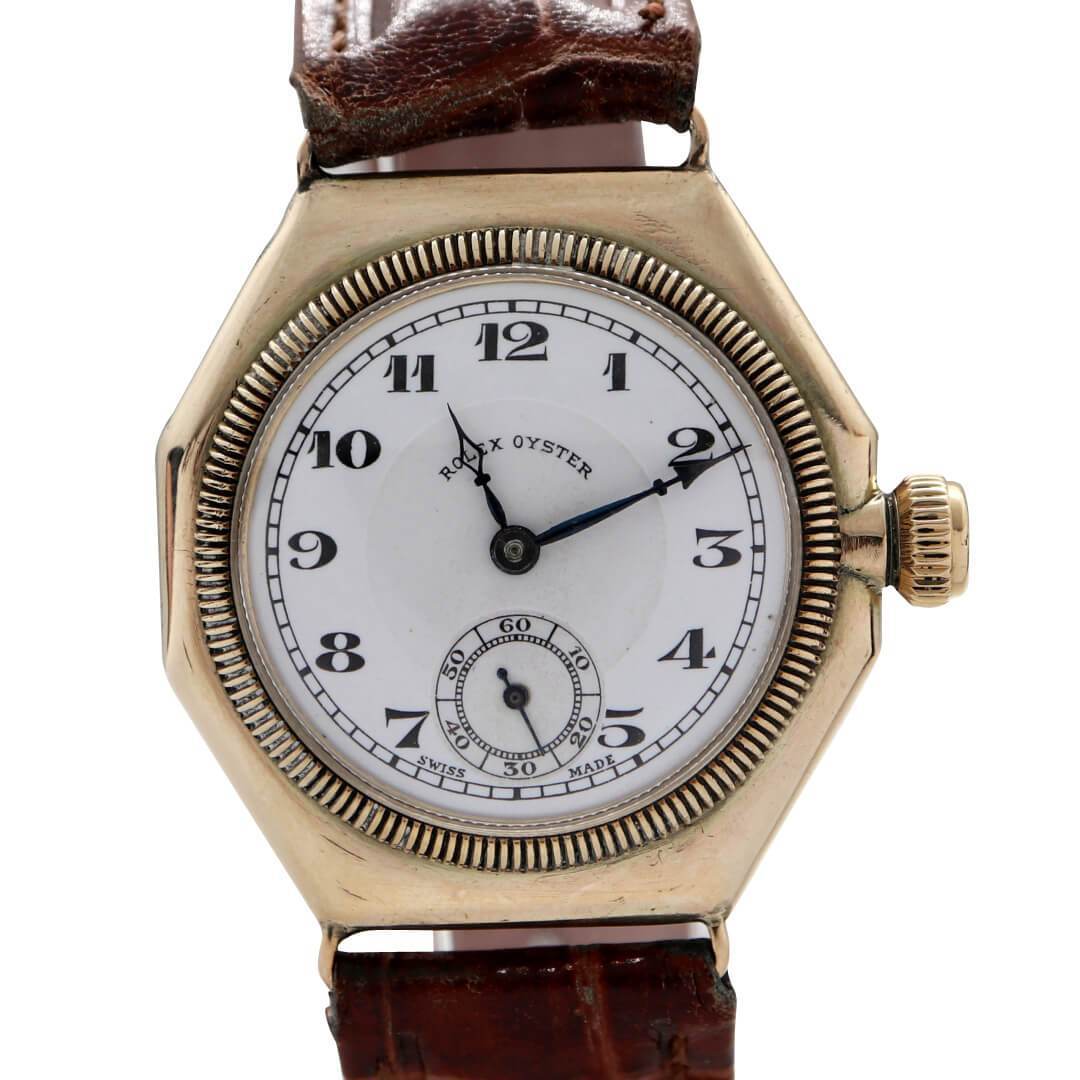


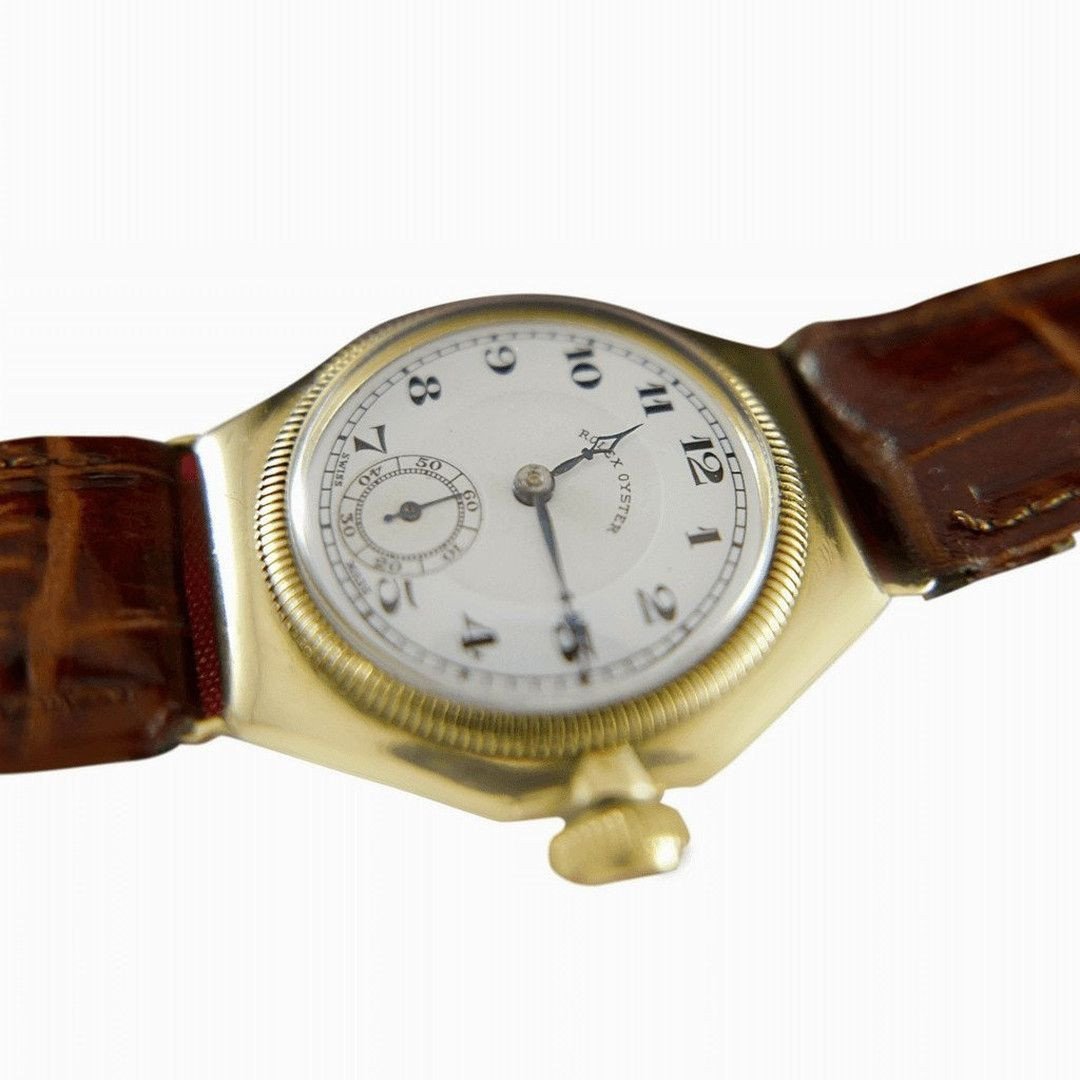






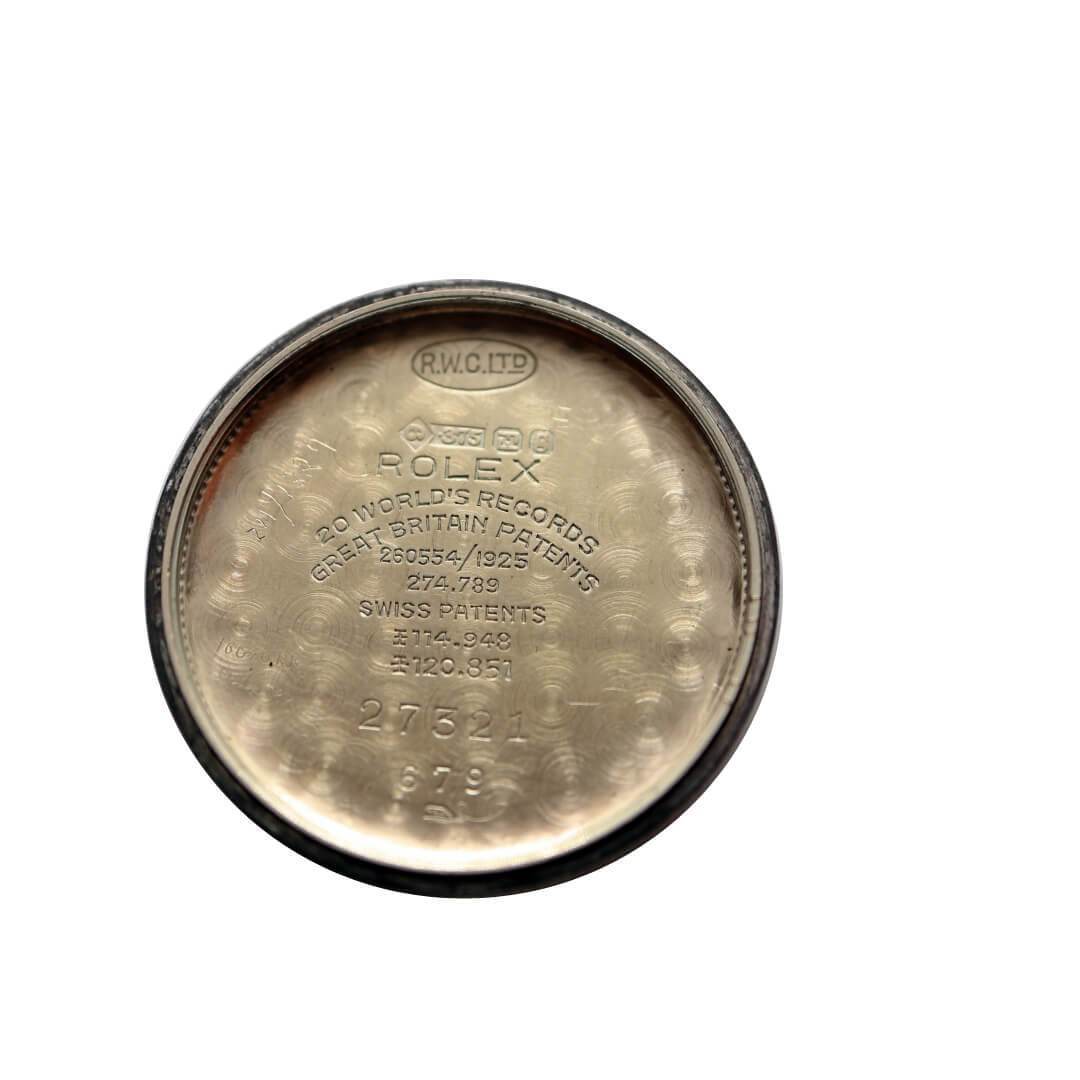



Key Information
Rolex Oyster Men's Vintage 1929 Gold Watch
Technical Information
Key Information:
- Brand: Rolex
- Model: Oyster
- Ref.:
- Year: 1929
- SKU: 1250
Technical:
- Movement Calibre:
- Movement Type: Manual
- Case Size: 32mm
Box and Papers:
- Our Own
Condition Report
Shipping & Returns
Shipping:
For orders placed before 2pm orders will be shipped the same day.
Your watch will be carefully packaged and shipped fully insured with leading global courier companies.
Delivery Prices:
Delivery within the UK is Free. Delivery within Europe is £60. Delivery for the Rest of the World is £80.
International Shipping.
Please note our site uses a third party app to auto calculate duties so the price you see is the price you'll pay (I.e. delivered duty paid).
The app charges a fee of approximately 2% which they apportion under the Shipping Cost. This is why this section may show a number higher than the base shipping fee.
Returns:
Don't like it or change your mind? Return it for a full refund with our 14 day, no hassle returns on all sales. See the full conditions here.
1 Year Warranty
All Our Watches are Covered by Our World-Class, 1 Year International Warranty.
Should your watch run into mechanical issues we'll repair it. For full details see our terms and conditions here.
Questions?
We're here to help!
Get in touch with our friendly team via:
- Phone: 02038156488
- WhatsApp: Click here to chat
- Email: support@timerediscovered.com
The Time Rediscovered Difference
Our mission is to make buying & selling vintage watches with us feel like dealing with a trusted friend, that's why you'll always get:
-

Fair Prices
Prices upto 30% cheaper than traditional dealers, see how we do it
-

Friendly Service
Friendly & never pushy. Contact us via phone, WhatsApp or Email
-

Guarantee on Form and Function
All watches are authenticated & serviced with transparent condition reports
WHAT PEOPLE ARE SAYING
"Best in class customer service. Time Rediscovered has restored my confidence in a flaky (at best) industry. Highly recommended."
- H Grizaard
Read what customers are saying here
*****





